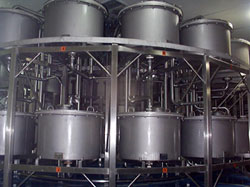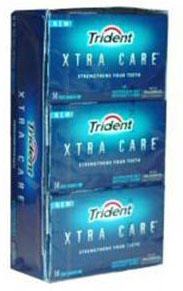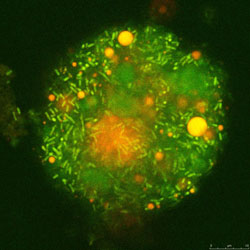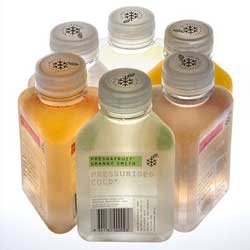 Dairy
constituents, notably the proteins and peptides, provide food companies
with a rich selection of potential ingredients for functional foods and
drinks. Dairy proteins and peptides provide desirable features such as
physical functional traits, nutritional qualities, and an increasing
array of substantiated bioactivities. The challenge for science and
technology has been to isolate these ingredients in a cost-effective
manner whilst maintaining their inherent functional and nutritional
traits. Continuous simulated moving bed chromatography (CSEP) provides
a solution and has been developed for the isolation of a number of milk
and whey-derived protein and peptide ingredients for use in the
functional food, sports nutrition and health foods markets. The
technology has several advantages over conventional chromatography
including efficiency, productivity and flexibility. In a ‘world-first'
for the Australian dairy industry, CSEP technology has been
successfully adapted for the manufacture of dairy ingredients enriched
in lactoferrin, glycomacropeptide and/or ß-lactoglobulin.
Dairy
constituents, notably the proteins and peptides, provide food companies
with a rich selection of potential ingredients for functional foods and
drinks. Dairy proteins and peptides provide desirable features such as
physical functional traits, nutritional qualities, and an increasing
array of substantiated bioactivities. The challenge for science and
technology has been to isolate these ingredients in a cost-effective
manner whilst maintaining their inherent functional and nutritional
traits. Continuous simulated moving bed chromatography (CSEP) provides
a solution and has been developed for the isolation of a number of milk
and whey-derived protein and peptide ingredients for use in the
functional food, sports nutrition and health foods markets. The
technology has several advantages over conventional chromatography
including efficiency, productivity and flexibility. In a ‘world-first'
for the Australian dairy industry, CSEP technology has been
successfully adapted for the manufacture of dairy ingredients enriched
in lactoferrin, glycomacropeptide and/or ß-lactoglobulin.
Geoffrey took a leading role in the introduction and development of this technology, including management of technology assessment, process development, validation, up-scaling and technology transfer, and aspects of commercialisation. He also took a key role in the creation and leadership of a science/technology-business partnership, which rapidly established the potential of the technology and the first of several commercial applications in the Australian dairy industry.
 Recaldent™
is
a natural milk-derived ingredient very effective in reducing the
incidence of dental caries and promoting oral healthcare. Recaldent™
is isolated from the major milk protein – casein – and is highly
enriched in phosphopeptides. During the manufacturing process these
phosphopeptides are complexed with calcium and phosphate, and this
complex is then dried to form the Recaldent™ ingredient. Animal and
human clinical trials have demonstrated the highly efficacious
properties of Recaldent™ in both preventing and repairing dental
caries. This ingredient is suitable for inclusion in a range of foods
and beverages, as well as personal oral care products. Such products
include functional chewing gum available
in the USA, Japan and other parts of the world, and professional
products for dentists.
Recaldent™
is
a natural milk-derived ingredient very effective in reducing the
incidence of dental caries and promoting oral healthcare. Recaldent™
is isolated from the major milk protein – casein – and is highly
enriched in phosphopeptides. During the manufacturing process these
phosphopeptides are complexed with calcium and phosphate, and this
complex is then dried to form the Recaldent™ ingredient. Animal and
human clinical trials have demonstrated the highly efficacious
properties of Recaldent™ in both preventing and repairing dental
caries. This ingredient is suitable for inclusion in a range of foods
and beverages, as well as personal oral care products. Such products
include functional chewing gum available
in the USA, Japan and other parts of the world, and professional
products for dentists.
Recaldent™ was developed in a project involving several partners, including CSIRO, Melbourne University and Bonlac Foods (now Fonterra). Geoffrey took a leading role in bringing together this successful partnership, and he also managed the process development, validation, up-scaling and technology transfer, and aspects of the commercialisation.
MicroMAX® MICROENCAPSULATION TECHNOLOGY
 MicroMAX®
is a simple but clever microencapsulation
technology, which uses only natural food materials and standard food
processing equipment, for protection of sensitive bio-functional
ingredients , for their successful delivery into functional foods and
drinks, and potentially for their targeted delivery to particular
points in the gastrointestinal tract. MicroMAX® is a patented platform
technology that relies upon the reaction between a protein or peptide
(with free amino group(s)) and a carbohydrate (containing a reducing
sugar) to form a very effective encapsulation matrix with exceptional
film-forming and antioxidant properties. MicroMAX® was initially
developed and optimised for encapsulation of fish oil, but has
subsequently been adapted to the protection of other essential oils,
oil-soluble bioactive components (e.g. vitamin E) and probiotic
bacteria.
MicroMAX®
is a simple but clever microencapsulation
technology, which uses only natural food materials and standard food
processing equipment, for protection of sensitive bio-functional
ingredients , for their successful delivery into functional foods and
drinks, and potentially for their targeted delivery to particular
points in the gastrointestinal tract. MicroMAX® is a patented platform
technology that relies upon the reaction between a protein or peptide
(with free amino group(s)) and a carbohydrate (containing a reducing
sugar) to form a very effective encapsulation matrix with exceptional
film-forming and antioxidant properties. MicroMAX® was initially
developed and optimised for encapsulation of fish oil, but has
subsequently been adapted to the protection of other essential oils,
oil-soluble bioactive components (e.g. vitamin E) and probiotic
bacteria.
Geoffrey has provided strategic input regarding design of the research program. He has also developed a large number of business relationships with local and global companies interested in using MicroMAX® in their products, fostered these relationships, and managed license negotiations based on protected bioactive, end-use application, and geographic region.
 Versagel™ is a natural and
healthy fat mimetic/substitute developed and patented by CSIRO to
facilitate the production of reduced-fat foods for the growing
health-conscious market. This ingredient is a premix powder formulated
to contain dairy protein and hydrocolloids that can be used to replace
fat in manufactured foods. Versagel™ can be used to produce a range of
novel reduced-fat meat, seafood, bakery and dairy products. By changing
the formulation, the appearance, texture, flavour and mouth-feel of
Versagel™ can be tailored for specific food applications. This
characteristic enables food processors to develop new product
formulations and styles with desirable sensory and nutritional
properties while significantly reducing their fat content.
Versagel™ is a natural and
healthy fat mimetic/substitute developed and patented by CSIRO to
facilitate the production of reduced-fat foods for the growing
health-conscious market. This ingredient is a premix powder formulated
to contain dairy protein and hydrocolloids that can be used to replace
fat in manufactured foods. Versagel™ can be used to produce a range of
novel reduced-fat meat, seafood, bakery and dairy products. By changing
the formulation, the appearance, texture, flavour and mouth-feel of
Versagel™ can be tailored for specific food applications. This
characteristic enables food processors to develop new product
formulations and styles with desirable sensory and nutritional
properties while significantly reducing their fat content.
Geoffrey has negotiated license and option arrangements for Versagel™ on the basis of end-use application and geographic region. The technology has been licensed in Australia, New Zealand and the Middle East, and is pending in the USA. Geoffrey has also assisted end-users to tailor and trouble-shoot the application of Versagel™ in their food products, leading to a range of successful commercial outcomes, including for example Hoffy Extra Lean Beef Franks in the USA .
NON-THERMAL PROCESSING TECHNOLOGIES
 Increasing consumer
demands for safe, natural and less
processed foods and drinks prompted the establishment of the Innovative
Foods Centre (IFC) in 2001 (with further expansion in 2005), a research
consortium between CSIRO, Food Science Australia and other
institutions, for the study, development and commercialisation of
alternative non-thermal food processing technologies in Australia. Such
technologies included high-power ultrasound, high pressure, pulsed
electric field, microwave and cool plasma. High pressure processing was
considered a key technology. Based upon work at the IFC, an Australian
‘start-up' has commenced commercial high
pressure processing of juices for sale in Australia and South-East Asia
Increasing consumer
demands for safe, natural and less
processed foods and drinks prompted the establishment of the Innovative
Foods Centre (IFC) in 2001 (with further expansion in 2005), a research
consortium between CSIRO, Food Science Australia and other
institutions, for the study, development and commercialisation of
alternative non-thermal food processing technologies in Australia. Such
technologies included high-power ultrasound, high pressure, pulsed
electric field, microwave and cool plasma. High pressure processing was
considered a key technology. Based upon work at the IFC, an Australian
‘start-up' has commenced commercial high
pressure processing of juices for sale in Australia and South-East Asia
Geoffrey took a key role in establishing the IFC, including co-authorship of successful grant proposals and business plans that attracted >$6 m in establishment costs. He was also very active in creating commercial awareness of the potential of non-thermal processing technologies, building robust business relationships, and negotiating equipment supply and maintenance arrangements often with overseas suppliers.